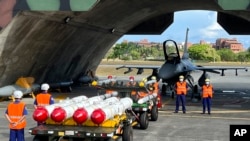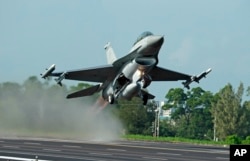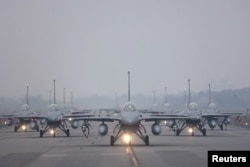Last week, the Biden administration announced a $345 million military aid package for Taiwan, marking the first use of presidential drawdown authority for the island.
On August 3, China’s state-run newspaper Global Times weighed in on U.S. arm sales to Taiwan:
"Converting the island of Taiwan into a ‘porcupine’ is a plan that benefits only the US, and selling such amounts of outdated yet overpriced weapons also brings huge profits to the US' military-industrial complex."
That is false.
Military experts told Polygraph.info that the U.S. has sent top-of-the-line equipment to Taiwan for many years. The Foreign Military Sales (FMS) system, through which Taiwan obtains most of its U.S.-made weapons, treats all foreign customers the same, including pricing.
These weapons are not overpriced. The price reflects higher U.S. labor costs, as well as U.S. systems’ more advanced technology and greater capabilities.
Taiwan now employs the “Porcupine Strategy,” also known as asymmetrical warfare, as its main military strategy towards China. First introduced in 2017 by the then-chief of the Taiwanese military forces, Lee Hsi-Min, it involves “a large number of small things,” requiring Taiwan to stock up on smaller anti-air, anti-tank and anti-ship weapons rather than larger weapon systems to fend off a possible attack from China.
Since the U.S. Congress passed the Taiwan Relations Act in 1979, Washington has been approving arms sales to the island to help it maintain a sufficient self-defense capability.
Are the weapons outdated?
Contrary to Global Times’ claim, many of the U.S. weapons sold to Taiwan are quite advanced in terms of both technology and capabilities. That would include the Javelin and Stinger missiles sold to Taiwan in 2015, the Stinger missiles sold to the island in 2019 and the Harpoon missiles and High Mobility Artillery Rocket Systems sold to it in 2020.
“For many years, the United States has sent top-of-the-line equipment to Taiwan. Taiwan's current requests include new F-16s, HIMARS rockets and Javelin antitank missiles. These are the same systems we are giving, or thinking about giving to Ukraine,” Mark Cancian, a retired U.S. Marine Corps reserves colonel who is a senior adviser at the Center for Strategic and International Studies, a Washington, D.C., think tank, told Polygraph.info.
For example, in 2019, the U.S. government authorized the sale of 66 newly-built F-16 fighter jets to Taiwan.
According to the aviation industry news site Flightglobal’s World Air Forces directory, there are currently 2,184 F-16s active worldwide. It is the single most popular combat aircraft, with 15% of the world’s fleet.
The F-16Vs ordered by Taiwan in 2019, which have not yet been delivered, come with enhanced avionics, missiles and radar systems to counter PLA fighter jets, J-20 stealth aircraft and J-16s, which regularly cross into Taiwan’s air defense identification zone.
Another example is the U.S.-made FGM-148 Javelin missile, which Taiwan sought to boost its defense capabilities.
As one of the world's premier portable anti-tank missile systems, the Javelin’s warhead is capable of destroying modern tanks by striking them from above, where the tanks’ armor is weakest. The U.S. approved the sale of 200 Javelin to Taiwan, to be delivered between 2023 and 2024.
Also in 2019, Taiwan purchased 108 M1A2T Abrams tanks from the U.S. The M1 Abrams tanks, which the U.S. began deploying in the 1980s, repeatedly proved their reliability and effectiveness in the Persian Gulf War and the wars in Iraq and Afghanistan, among other conflicts.
Other countries, including Kuwait, Saudi Arabia, Egypt and Australia, also use Abrams tanks.
The MIA2 comes with improved capabilities, including thermal sights, and can shoot two targets simultaneously.
Therefore, the U.S. has provided Taiwan with top-of-the-line weapons. CSIS’s Cancian noted that Taiwan tends to hold onto systems for a long time, making some of its systems, particularly in the island’s army, outdated.
Are the weapons overpriced?
Global Times also claimed that the U.S. weapons sold to Taiwan are overpriced.
Virtually all U.S. systems are more expensive than comparable systems produced by other countries, including China. According to Cancian, this “partly reflects higher U.S. labor costs, but partly also reflects the more advanced technology and greater capability of U.S. systems.”
Lee Hsi-Min, the former chief of staff of the Taiwanese armed forces who now is a senior fellow at the Project 2049 Institute, a think tank in Arlington, Virginia, told Polygraph.info that the Foreign Military Sales (FMS) system through which Taiwan obtains most of its U.S.-made weapons treats all foreign customer countries the same, including pricing.
An FMS program, he said, is comprised of subsystems, spare parts, logistical support and training, among other factors that make direct price comparisons difficult.
At the same time, many factors can affect the cost of a particular weapon at a particular time, including production line availability and the ability of a producer to offer discounts on the weapon if it is being sold to more than one customer.
“Such variations in costs affect all FMS customer countries, including Taiwan,” Lee said. “Therefore, the U.S. weapons sold to Taiwan are not overpriced.”
The latest $345 million in military aid to Taiwan is part of a drawdown from existing U.S. weapons stocks, meaning Taiwan is essentially getting the weapons for free.







